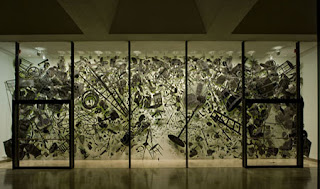Check out this link for some inspiring art work and artist presentations. http://www.artbabble.org/
ISB Visual Art
Tuesday 4 December 2012
Sunday 30 September 2012
Artist Documentation Program
http://adp.menil.org/
This link is a fantastic resource for hearing first-hand accounts of the artist's intentions and use of materials. After creating a log-in, you can watch interviews conducted "to gain a better understanding of their materials, working techniques, and intent for conservation of their works. All interviews are conducted by conservators in a museum or studio setting".
I haven't watched them all, but so far my favorite interviews are with artists:
Tim Hawkinson
John Currin
Jasper Johns
Dario Robleto
http://adp.menil.org/
This link is a fantastic resource for hearing first-hand accounts of the artist's intentions and use of materials. After creating a log-in, you can watch interviews conducted "to gain a better understanding of their materials, working techniques, and intent for conservation of their works. All interviews are conducted by conservators in a museum or studio setting".
I haven't watched them all, but so far my favorite interviews are with artists:
Tim Hawkinson
John Currin
Jasper Johns
Dario Robleto
http://adp.menil.org/
Saatchi Gallery Online
Saatchi gallery is currently featuring an initiative called 100 Curators 100 Days. Check back daily to see exciting, contemporary art from around the globe. http://www.saatchionline.com/100curators
Here's a sample, from the MANY that caught my eye:
 |
no title Drawing by Ana Vujovic |
 |
VIC The LurcherSculpture by Gaynor Ostinelli |
 |
A Silver Liningassemblage/collage by Charles Wilkin |
 |
Haircut 1 (with Andrew Tamlyn)assemblage/collage by Erin Case |
Friday 14 September 2012
Pereda - art and mischievousness
Odds are that you've heard me promote the Art21.org series before, because there is such a range of great stuff on their website, videos and blog. I particularly enjoyed this energetic, positive, 9 minute video about the artist Alejandro Almanza Pereda. Check out this amusing slice-o-life on what it is like to be an artist in New York City.
http://www.alejandroalmanzapereda.com/index.php?/selected-works/just-give-me-a-place-to-stand/
More information on the following images can be found at alejandroalmanzapereda.com
Thank you Art21 for being such a rich art resource!!
http://www.alejandroalmanzapereda.com/index.php?/selected-works/just-give-me-a-place-to-stand/
More information on the following images can be found at alejandroalmanzapereda.com
 |
| If I understood correctly, this image (above) was created with one 9B pencil. |
Tuesday 11 September 2012
When our objects own us. . . and the "life" they contain.
Artist Mark Fox started with simple drawings and the idea of clutter to create his Dust installation. The work considers the current human situation, as it relates to our many possessions. On the Rice Gallery link below, there is a video of Fox explaining his purpose and process - good insight for how you might discuss your own work.
http://www.larissagoldston.com/exhibitions/foxuntitled/index.aspx
In his 2010 exhibition, he investigated text, creating word wallpaper. The below images are from his gallery site.
http://www.larissagoldston.com/exhibitions/foxuntitled/index.aspx
Wednesday 5 September 2012
Inspirational documentary of Basquiat
The film called Radient Child by Tamra Davis is an inspiring documentary of Jean-Michel Basquiat, with actual footage from an exciting period of the NYC art scene. The movie begins with rare footage of a friend interviewing Basquiat just two years before he died. http://youtu.be/wuZZ3gY2_9I
Here is the webpage for the documentary http://www.jean-michelbasquiattheradiantchild.com/
The film is worth a watch particularly because of the way it provides a glimpse into the artistic process, even if you don't care for Basquiat's urban, expressive, bold style. Basquiat is an excellent artist to look at for ideas on how to naturally inform your artwork through your own interests (to fulfill the historical/cultural assessment criteria).
 |
| Jean-Michel Basquiat in his studio, 1985. Photograph © Lizzie Himmel |
Tuesday 4 September 2012
Presenting your research in the IWB
Below are examples of workbook pages that creatively present research. Notice how in the examples below the titles and backgrounds are artistic. This should never be pointless decoration, but rather a compliment to the style of the work you are presenting.*(see "warning" below)
A word of warning, some students become very involved with backgrounds and spend far too much time making "pretty" pages. If you find that you really enjoy spending time on backgrounds, perhaps consider using that motivation to create an abstract, color-field paintng on canvas instead. That way you get to enjoy the same process but it counts as a final!
 |
| A quote relating to the style of work or directly from the artist, is a great way to introduce us to the concepts. |
Plenty of images and your own study of the work make for a visually diverse page.
Subscribe to:
Posts (Atom)









